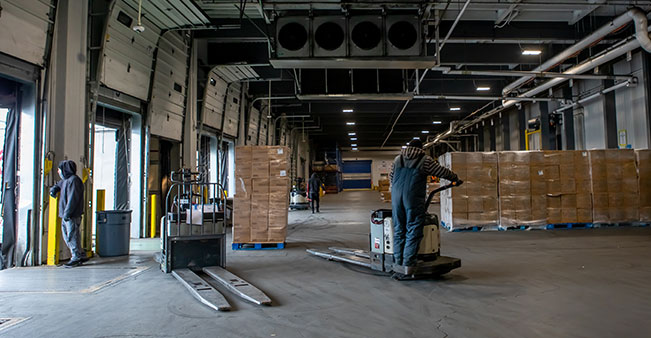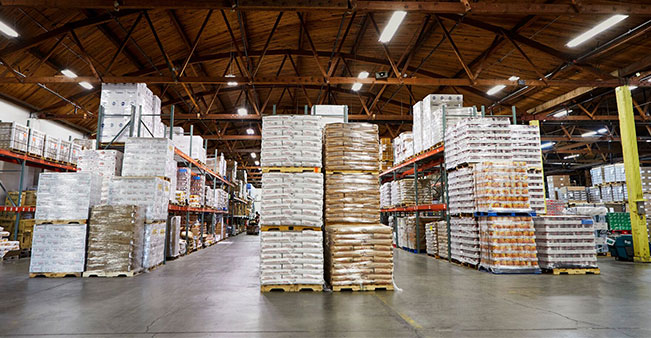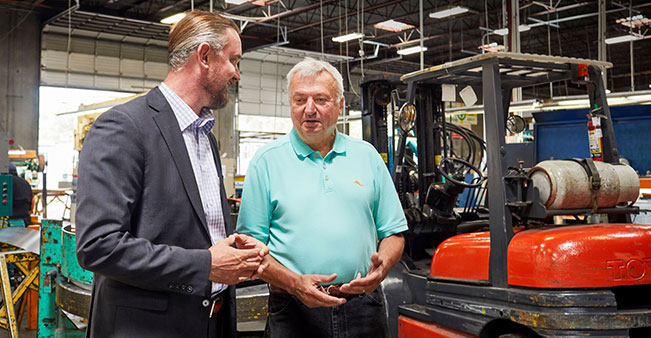Strategic Investments
To help businesses plan for the future, Umpqua Bank worked with economic experts to get their take on key trends and predictions for the year ahead. We also had our own leaders weigh in on how small and mid-sized businesses in the West can use this information to better position themselves.
Jump to: Automation · Commercial Real Estate · Mergers & Acquisitions
Umpqua Client:
Merlino Foods
Automation
Automating tasks has become increasingly popular among small and mid-sized businesses.
“We used to worry that robots would take people’s jobs. Now we hope that robots will fill empty positions,” said economist Bill Conerly.
Conerly said that businesses are ordering more computers, machinery, and equipment. The price for such equipment has been flat to down over the past decade, while the cost of labor has risen significantly. So, ideas about automation that did not pencil out three years ago should be looked at again.
He also noted that artificial intelligence will continue to spread across many business applications, especially in marketing, customer service, and accounting.
“Economic downturns provide incentives to automate,” said economic analysis firm ECONorthwest. “Revenues fall while wages typically don’t, which makes labor relatively expensive and automation attractive.”
The pandemic added reasons to automate, according to the firm. Machines can socially distance, and sizable federal grants and loans expanded businesses’ investment budgets. Despite these incentives, it’s unclear if automation accelerated during the past 18 months or simply continued eliminating routine jobs at the same, steady pace that it has over the past half century.


In 2022, investment in automation should be prominent in industries that face the greatest wage pressures. Beyond that, technologists will continue to improve robotic, artificial intelligence, and machine learning capabilities. And as important, they will work to improve customer and public acceptance of the technologies, which to date, slowed the pace to adoption.
Automation is not just for big firms with deep pockets. Many artificial intelligence and machine learning technologies have, and will be, available to businesses of all sizes down to sole proprietors. Advanced software is available to scan, analyze, and summarize documents; label data, assemble and forecast business trends; provide phone support; transcribe verbal messages and more.
Persistent wage pressure means more leisure, hospitality, and retail businesses will invest in automation, said ECONorthwest. Businesses will look to automate the routine tasks conducted by cashiers, salespeople, administrative assistants, and stock and material movers. Restaurants and bars will continue with contactless ordering online or through phone applications. Similarly, online booking sites and self-service kiosks will reduce demand for travel agents and hotel desk clerks.

Kathryn Albright
Head of Global Payments & Deposits
Umpqua’s Kathryn Albright on Automation and Payments
“We’re seeing more and more businesses automate and digitize basic functions in response to the talent shortage and to avoid gaps in productivity. One smart way just about any business can do this in 2022 is by automating their payments and accounts receivables process. It’s relatively simple and can yield significant savings, especially given the difficulty of hiring and retaining workers.”
Schedule a Working Capital Assessment
Commercial Real Estate
The pandemic has led to a major shift in demand and supply for commercial real estate. Companies of all sizes may and should be reevaluating their position.
“Commercial real estate changed radically in the COVID-19 pandemic,” said Bill Conerly.
Demand for traditional retail and downtown office space dropped and warehouse space is in high demand, as is suburban office demand. The shift to hybrid work, or to more suburban locations may hurt downtown office and nearby retail for years. And with fewer people needing to commute, the population may shift toward the suburbs, helpings the stores, restaurants, and offices there.


ECONorthwest points out that return to the office policies vary considerably across the country, mirroring differing regional attitudes about social distancing and virus risk aversion. Those attitudes, in turn, are reflected in demand. Areas of Texas, for example, show far higher occupancy of office space than in California.
ECONorthwest said that industrial and multifamily sectors are bright spots in the commercial real estate market. Demand for industrial facilities is strong as companies attempt to bring inventory closer to customers and, in the West, manufacturers demand additional space. Multifamily housing is strong across growing markets because of two decades of underproduction and increasingly pro-housing supply policies.
They said that the multifamily housing sector shows promise in 2022 and thereafter. West Coast policymakers are making the connection between the lack of housing supply and associated affordability and homelessness crises. California has followed Oregon’s lead and enacted statewide zoning reforms to boost supply. Many local governments and neighborhoods will continue to resist the state efforts. Fiscal carrots and sticks will be key to the reforms meeting their development goals.
Umpqua’s Kent Grubaugh on Strategic Investments
“Eventual corrections in the real estate and equities markets will present those with liquidity opportunities for strategic investments. Take advantage of the continuing low interest environment while you can. Securing the right line of credit ahead of potential market corrections will allow for quick action. Keeping cash on hand is another option, but inflation is depreciating its value, while a line of low-interest, untapped credit may make more strategic sense.”
Talk to a banker

Kent Grubaugh
Head of Private Bank
Mergers & Acquisitions
Businesses have always had an interest in growth, but there’s been a surge in merger and acquisition activity of late to drive those gains.
Business owners in slow-growth industries may be frustrated with the pace of organic growth, so may look to expand by acquiring competitors or high growth opportunities, said ECONorthwest. Similarly, there is the defensive strategy of buying firms that are steps ahead in innovation.
Less risky though, is acquiring a firm in your own regional market that leads to increased pricing power, which economists call market power. This is common in sectors with tight regional markets, such as construction contracting, aggregates mining, farming, self-storage, warehousing, and even banking.
All these driving interests are based on the expectation of increasing profit margins enough to offset the cost of capital. And the latter has been fueling much of the M&A activity in the U.S. since 2017, the firm said. Not because acquisitions are cheaply priced — they’re not — but because capital is abundant, stock prices high, and interest rates unusually low.


ECONorthwest said it’s impossible to predict with much accuracy what industries on the West will be most active in M&A. But there are a few industries where conditions are favorable, including middle-market general contractors and subcontractors. And if interest rates rise into late next year, conditions would be good for cash-rich firms to approach competitors with retiring owners or those that are in weaker financial positions.
Branded food manufacturers, again middle market, are a perennial target for acquisition. With inflation rising and household budgets stressed, niche food makers will be compelled to find ways to get their products into the hands of consumers at lower price points. And should the stock market fall, technology firms that had once planned on going public become more likely to seek M&A.
The farming sector should continue to consolidate. Land prices rose so much in recent years that land purchases are out of reach for many farm families. Long-term leasing is becoming more prevalent, and this will likely continue.
Key Takeaways
-
Automation will continue and grow in 2022.
-
Uncertainty in the office sector will continue into 2022 as most employers haven’t pinned down their workplace expectations.
-
The commercial real estate market has been reshaped by the pandemic, with less demand for downtown office space and retail and increased demand in warehouse space and suburban office space.
-
M&A has surged as companies capitalize on low interest rates, improved liquidity, and need for growth.
Connect with an Umpqua banker to learn how we can help position your business for the future
Umpqua Bank works closely with its clients to truly understand their businesses and provide the best financial solutions for their needs. We have the market and financial expertise to help you prepare for whatever the future holds. If you’d like to talk with one of our bankers, fill out the form.

More Areas of Insight
The Economy
A look at the economy as a whole, including areas of major change like inflation.
Get the insights
Major Disruptions
We dive in deep on key macroeconomic issues such as supply chain and labor market challenges.
Get the insights
U.S. Policy & Cybersecurity
The policy issues that will matter the most in 2022 and including cybersecurity in your planning.
Get the insights







